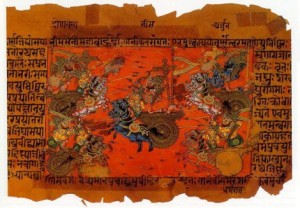Political Organization and Form of Government in Vedic Period
1 min read
Vedic literature provides very little informations about political history during Vedic period. Persons, battles and political events mentioned in the Vedas cannot be arranged chronologically (except for that they took place during Vedic period), while much of the historical context in Vedic literature is unclear.

Punjab region was the center of the Vedic culture and from there Indo-Aryans expanded to the east. The basic political unit was the vish (clan or tribe) ruled by raja (king or chief) who was responsible for protection of the clan. The clans did not only struggle with the non-Aryan tribes which they called Dasyu but were frequently in conflicts with each other as well what clearly indicates the Battle of the 10 Kings which is described in Rigveda. Rivalry between the clans is also the central event of the great epic poem Mahabharata (composed between 400 and 200 BC) which says that rivalry between sibling clans of Kauravas and Pandavas provoked the Kurukshetra War in which participated number of other kingdoms as allies of the rivals. The epic Mahabharata represents the 18-day war as a major event of great significance for the future history. However, it remains uncertain whether the famous war was as significant as described or the author (Vyasa) only glorified a battle of local importance.
Clan identity was slowly replaced by territorial identity by the end of the Vedic period and 16 kingdoms known as the Mahajanapadas emerged in the northern part of the Indian subcontinent competing with each other for supremacy. At the same time kingship became hereditary.